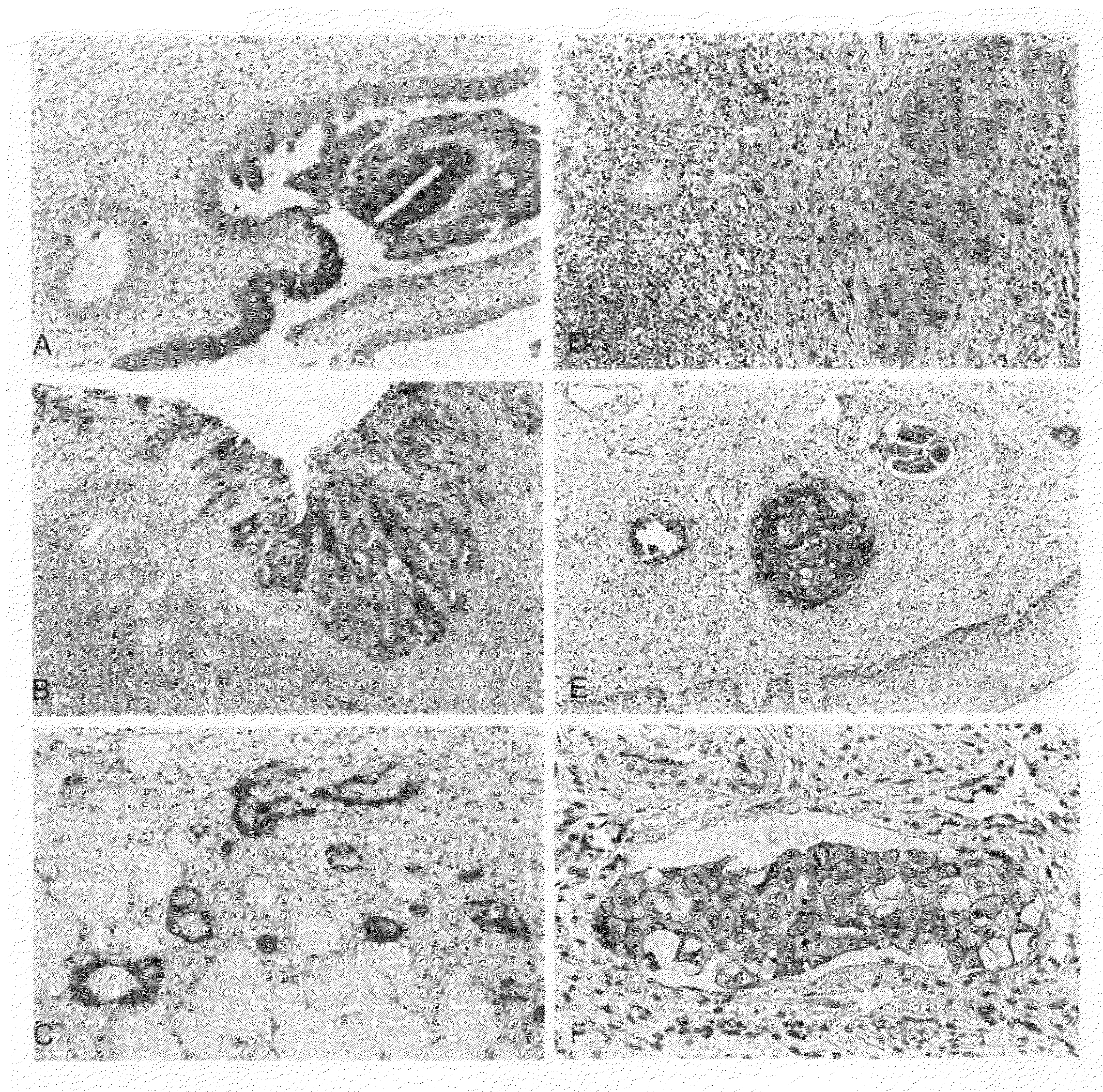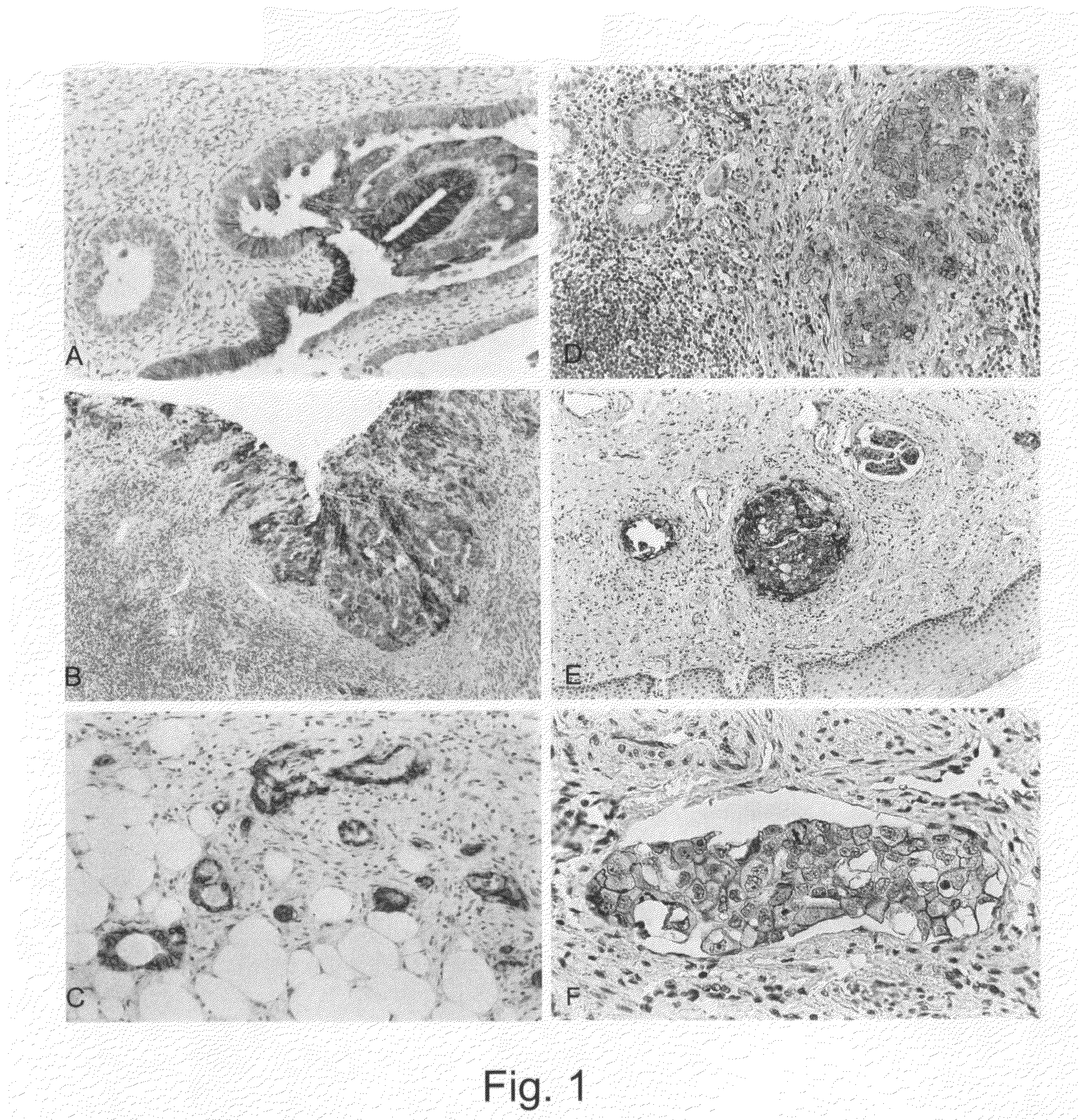Diagnostic and therapeutic methods based on the l1 adhesion molecule for ovarian and endometrial tumors
- Summary
- Abstract
- Description
- Claims
- Application Information
AI Technical Summary
Benefits of technology
Problems solved by technology
Method used
Image
Examples
example 1
The Examination of Curettage Tissue Shows a High Correlation Between the Expression of L1 and the Clinical Stage and the Pathological Degree of the Tumors, Respectively
[0044]Tumor tissue is embedded in paraffin according to standard methods and serial sections are made. Following the treatment of the sections in the microwave oven (10 min., 92° C.) in the presence of 1 mmol EDTA (pH 8.0) immunostaining of the tissue is carried out by means of the MCA1753 antibody (Biozol Diagnostica Vertiebs GmbH). The bound first antibody is detected by means of an enzyme-coupled second antibody (Vector ABC Kit; www.vectorlabs.com). Some exemplary stainings are shown in FIG. 1. The clinical data are listed in Tables 1 and 2.
[0045]FIG. 2 shows that L1 can also be detected by means of curettage tissue. Using the above described procedure, a similar staining pattern as on the tumor sections results. The determination of L1 by means of curettage material permits an early preoperative classification of ...
example 2
ELISA Shows the Presence of Soluble L1 in Sera and Ascitic Fluid of Tumor Patients, a Correlation Between the Presence of L1 and the Tumor Type (Ovarian and Endometrial Tumor) Being Observed
[0046]Samples of body fluids (ascites, serum) were tested for the presence of soluble L1 using a “capture” ELISA. For this purpose, microtitration plates were coated with the human anti L1 antibody (concentration: 1 μg / ml) described in Example 1 and then a blocking step was carried out with 3% BSA in PBS (45 min., room temperature) to eliminate the non-specific bonding to the plate. The body fluid was added at differing concentrations (1:2 and 1:10 of the fluid in 3% BSA in PBS), and incubation was carried out at room temperature for 1 hour. Therefore, four wash steps followed in Tris-buffered common salt solution (TBS, pH 8.0, in the presence of 0.02% Tween-20). Bound soluble L1 was determined by the addition of human biotin-conjugated anti L1 antibody. For this purpose, the biotinylated antibod...
example 3
A New ELISA Format for the Detection of Soluble L1
[0048]The ELISA described above in Example 2 used the coating of the microtiter plate with L1 mAb 1 (capturing monoclonal antibody) and the detection of soluble L1 with a biotinylated (or otherwise labelled) L1 mAb 2 (detecting monoclonal antibody). This type of ELISA is termed G / K format. We have now developed another format in which we use both for capturing and detection the same mAb to L1 (K / K format). In FIGS. 5 A and B a comparison of both types of ELISA is shown using a positive serum (CA526, ovarian tumor patient) and seval control sera from unrelated tumors. It is obvious that the new ELISA format in FIG. 5B gives a better signal to noise ratio (appr. 5-8 fold) than the previous format shown in FIG. 5A. As the K / K format can only work when the antibody epitope for detection is not blocked by the antibody used for capturing, these results implicate that in the serum sample the soluble L1 is dimeric or multimeric. The control ...
PUM
| Property | Measurement | Unit |
|---|---|---|
| pH | aaaaa | aaaaa |
| concentration | aaaaa | aaaaa |
| adhesion | aaaaa | aaaaa |
Abstract
Description
Claims
Application Information
 Login to View More
Login to View More - R&D
- Intellectual Property
- Life Sciences
- Materials
- Tech Scout
- Unparalleled Data Quality
- Higher Quality Content
- 60% Fewer Hallucinations
Browse by: Latest US Patents, China's latest patents, Technical Efficacy Thesaurus, Application Domain, Technology Topic, Popular Technical Reports.
© 2025 PatSnap. All rights reserved.Legal|Privacy policy|Modern Slavery Act Transparency Statement|Sitemap|About US| Contact US: help@patsnap.com



